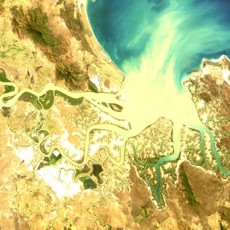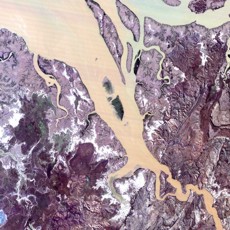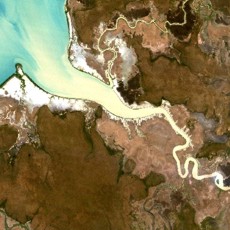Also known as: macrotidal estuaries, open estuaries.
Conceptual model diagrams of tide-dominated estuaries
 Physical Characteristics
Physical Characteristics
Sedimentary Environments (Habitats)
Positive Hydrology
Negative (or Reverse) Hydrology
Sediment Transport
Nitrogen Dynamics
Key features of tide-dominated estuaries
- A diverse range of both marine and brackish, subtidal, intertidal and supratidal estuarine habitats are supported. Intertidal and supratidal areas are often extensive, whereas turbidity may preclude seagrasses in some areas.
- Large entrance promotes efficient marine flushing.
- River flow is typically high, however the effects of floods are buffered by large water area, and large tidal exchange.
- Turbidity is naturally high due to strong turbulence induced by tides.
- Flanking environments such as intertidal flats, mangroves, saltmarshes and saltflats tend to trap terrigenous sediment and pollutants. Marine flushing results in loss of some material to the coastal ocean.
- Tidal movement over flanking environments encourages the trapping and processing (e.g.denitrification) of terrigenous nutrient loads. Marine flushing results in loss of some material to the coastal ocean.
- ‘Semi-mature’ in terms of evolution: infilling by marine and terrigenous sediment will result in expansion of flanking environments, narrowing of channels, and seaward progradation.
A tide-dominated estuary represents a bedrock coastal embayment that has been partially infilled by sediment derived from both the catchment and marine sources, in which tidal currents, rather than waves, are the dominant force shaping the gross geomorphology. In Australia, tide-dominated estuaries are generally found on the northern, north-eastern and north-western coasts, and are most abundant on low-gradient coasts characterised by meso- to macro-tidal ranges (Harris et al., 2002, Dalrymple, 1992).
Geomorphology
Tide-dominated estuaries generally consist of a landward-tapering funnel shaped valley, bounded by various intertidal sedimentary environments such as intertidal flats, mangroves, saltmarshes, and saltflats. Depending on the degree of sediment infilling, the boundaries of tide-dominated estuaries may follow the irregular outline of the drowned valley (Riggs et al., 1995), or, in more mature cases are smooth and intersected by small tidal creek dendritic drainage networks (Wells, 1995, Wolanski et al., 1992).
Major structural elements inside the estuary include elongate tidal sand banks, which occur in the wide entrance, oriented perpendicular to the coast and parallel to the direction of dominant tidal currents (Fitzgerald et al., 2000, Green et al., 2001). The tidal sand banks are usually dissected by deep channels containing strong tidal currents. Landward of the estuarine channels, the source river that feeds into tide-dominated estuaries often features a straight–meandering–straight river channel profile (see East Alligator River, below). This represents the point at which the convergence of seaward-directed water and sediment transport by the river, and landward-directed water and sediment transport by tides occurs (Dalrymple et al., 1992, Bryce et al., 1998). Due to strong tidal currents generated by large tidal ranges, tide-dominated estuaries are usually highly turbid.



Figure 1.Examples of tide-dominated estuaries: the Fitzroy River (QLD), the Victoria River (NT), and the East Alligator River (NT).
Evolution
Tide-dominated estuaries evolve by infilling of the valley with terrigenous and marine-derived sediment, and a gradual translation of geomorphic and sedimentary environments in a seaward direction (Dalrymple et al., 1992). Quantification of the area of geomorphic and sedimentary facies in Australia’s tide-dominated estuaries (Heap et al., In Press) has demonstrated that there is no (or very little) significant change in the distribution of sedimentary environments during evolution. However, infilling is characterised by the expansion of intertidal flats and saltflats around the margins of the estuary, and expansion and merging of tidal sand banks in the tidal channels (Harris, 1988), reflecting the deposition of sediment trapped within the estuary. Vegetation associated with mangrove, saltmarsh, and saltflat environments plays a major role in determining the form of the estuary during early stages of evolution, because of its capacity to trap fine sediment (Woodroffe, 1992, Woodroffe et al., 1993). As such, tide-dominated estuaries have undergone a ‘Big Swamp’ evolutionary phase, that was characterised by the rapid expansion of marginal marine environments. This was followed by relatively slow accumulation that enabled freshwater wetlands to gradually replace mangroves and saltmarshes, and slow seaward progradation (Woodroffe et al., 1989, Mulrennan et al., 1998, Chappell, 1993, Woodroffe et al., 1993).
Habitats and ecology
Tide-dominated estuaries contain habitats such as channels, intertidal mudflats, mangroves, saltmarshes, saltflats, and rocky shores and rocky reefs (Semeniuk, 1982). These habitats typically support marine species, including transient visitors and permanent residents (Cyrus et al., 1992, Pusey et al., 1993), however the biota of these estuaries is less well documented than their wave-dominated counterparts (Boyd et al., 1992). Plant productivity seems to increase with increasing tidal range, due to greater rates of flushing and the consequent renewal of nutrients (Morrisey, 1995). Littoral mangrove forests dominate many of Australia’s tide-dominated estuaries, and plains vegetated with grasses, sedges and herbs, as well as freshwater wetlands and floodplain vegetation (such as Melaleuca spp.) lie above the influence of most (but not all) tides (Woodroffe et al., 1989). Turbid water within the estuary largely precludes the growth of subaquatic benthic macrophytes (such as seagrasses), and also limits the distribution and depth range available as habitat for phytoplankton. These species are able to survive further seaward due to lower turbidity (Semeniuk, 1996).


